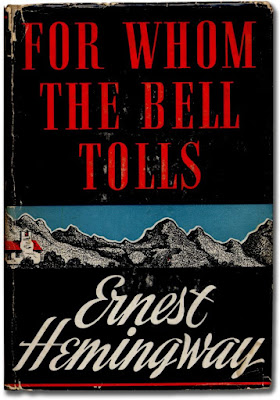Much can be said about For Whom the Bell Tolls. There are endless reviews, essay papers, and podcast episodes dedicated to the novel and its characters. Heminway wrote it in different locations, Cuba, Florida, and Idaho, and based it on his experiences covering the Spanish Civil War for the North American Newspaper Alliance. At this point in the author's career, Hemingway had already witnessed firsthand the atrocities of World War I as an ambulance driver for the Red Cross. I believe both experiences contributed to his writing style and subject matter in For Whom the Bell Tolls.
From a sky-level perspective, the novel is very simplistic in nature. But, deep in the scorched Earth, with the bullets, dirt, and rubble, it is a more complex tale of war and the insurmountable circumstances that force humans to kill humans in an endless cycle of violence and bloodshed. It is just as relevant today as it was in 1940, as America was on the cusp of entering World War II. In that sense, it is a timeless novel that will unfortunately still be relevant 50 years from now. War is war, no winners, just combatants.
Robert Jordan, an American professor of Spanish, left the University of Montana to teach in Spain. As the country turned into a melting pot of civil unrest and saber-rattling, Jordan finds himself as a fighter for the republicans, a doomed opposition to the fascist forces that would eventually envelope Spain under Francisco Franco's dictatorship. Through perseverance, and luck, Jordan becomes an experienced dynamiter. Off-page, he is asked by a Russian general to aid a band of local guerrillas in destroying a bridge. With the bridge's destruction, it will prevent fascist forces from advancing their troops.
The local guerrilla force is made up of an old gypsy, an alcoholic leader, a lazy fighter, a strong female fighter, and an assortment of experienced, middle-aged fighters. None of these people want to join the republican military, but instead independently conduct military exercises. Unfortunately, their only major accomplishment in the war is the destruction of a train. Beyond that, it is mostly just all talk. But, it is Jordan's role as the experienced dynamiter, to somehow work with these men and women to complete the mission.
At roughly 500 pages, Hemingway spends most of the narrative conducting deep discussions between his assortment of diverse characters. Perhaps the best of these is presented in Chapter 10. As an avid reader of ultra-violent men's action-adventure novels, gritty vigilante sagas, and rip-roaring westerns, I've never encountered more powerful, unrestrained passages as what Hemingway puts to paper as Pilar and Pablo describe the liberation of the small town of Avila. The homicidal, savage killing of the town's fascist leaders and businessmen is one of the most brutal and disturbing things I've ever read. My assumption is that this chapter alone probably excluded the novel from being recognized for a Pulitzer Prize. It is such a moving piece in its surreal, heart-wrenching detail of men dying for their beliefs.
Equally as disturbing is Chapter 31, an account made by Jordan's love interest, his “little rabbit” Maria. I was teary-eyed as I read the terrifying ordeal she faced as the fascists destroyed her town, killed her parents, and then took turns brutally raping her. She confesses to Jordan that she has been physically injured by the ordeal, a wound that becomes very painful when the two make love. This passage, appearing later in the novel, balances the war-torn strife – republicans kill fascists, fascists kill republicans. Hemingway's presentation is terrifyingly brilliant, showing that both sides are equally evil and corruptible.
As a literary powerhouse, For Whom the Bell Tolls is a masterpiece. But, specifically for Paperback Warrior fans of high adventure, military-fiction, and men's action, there is plenty to love about this mainstream classic. Hemingway places the action in Spain's high passes and snowy mountains. This is a narrative that possesses intense action sequences as the guerrillas attempt to defend a mountain from an onslaught of fascist forces and planes. It's this scene in particular that is a consuming, bullet-ridden piece of the narrative that is excellently described by Hemingway. The reader gains a unique sense of destruction, despair, and impending doom. The same can be said for the book's flourishing finale, an epic, high-octane sequence of events that places Jordan in a final conflict against waves of enemy troops. These scenes are staggering and left me feeling gutted.
Nothing else can really be said here to express the magnitude of For Whom the Bell Tolls. You owe it to yourself to read the novel, to feel and hear the novel in your own way. It is just a powerful piece of literature that could never be fully served by a theatrical approach. Despite nine Oscar nominations for the 1943 film, the old adage “the book is better than the movie” has never rang more true.
Buy a copy of this book HERE.



